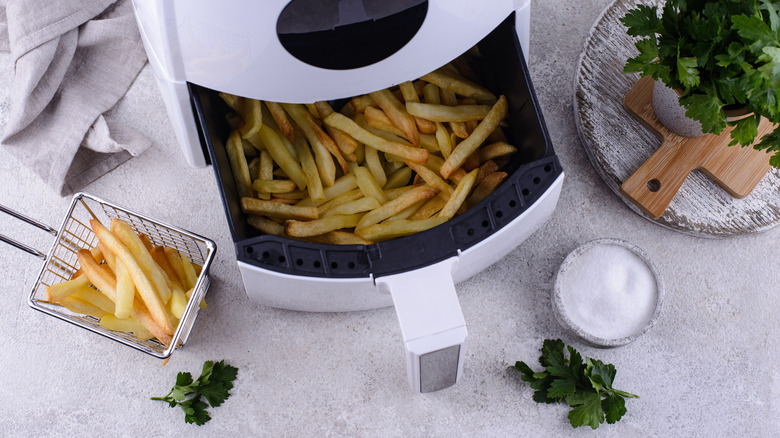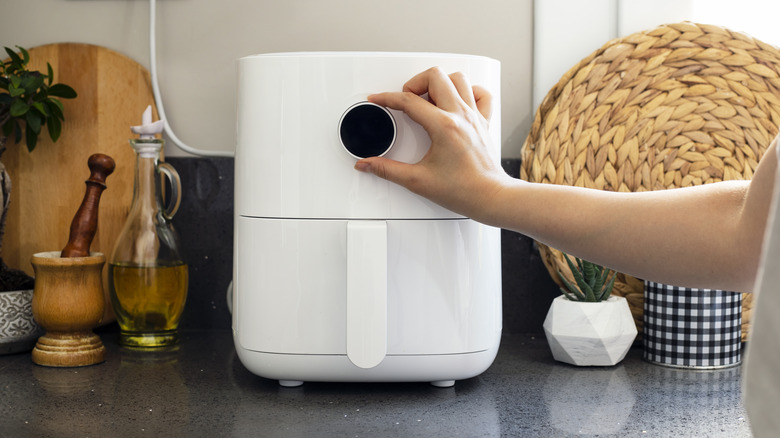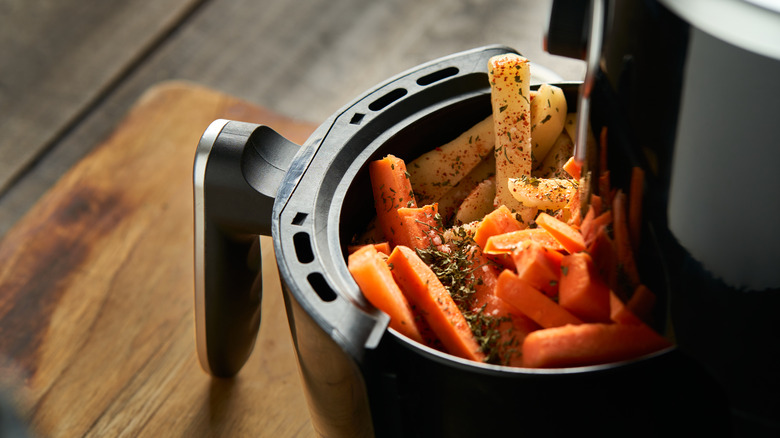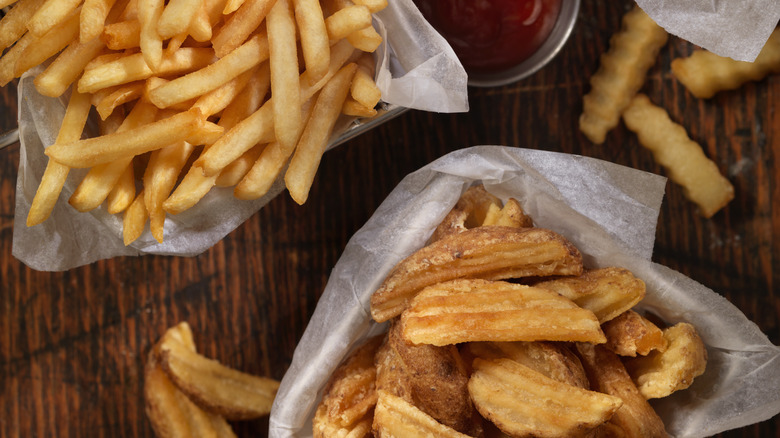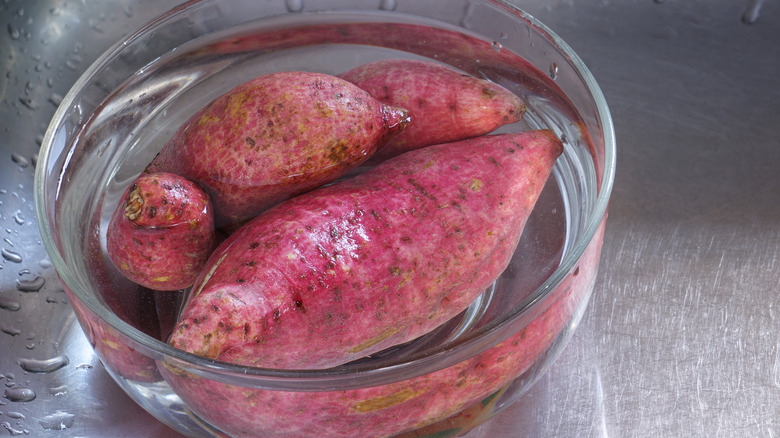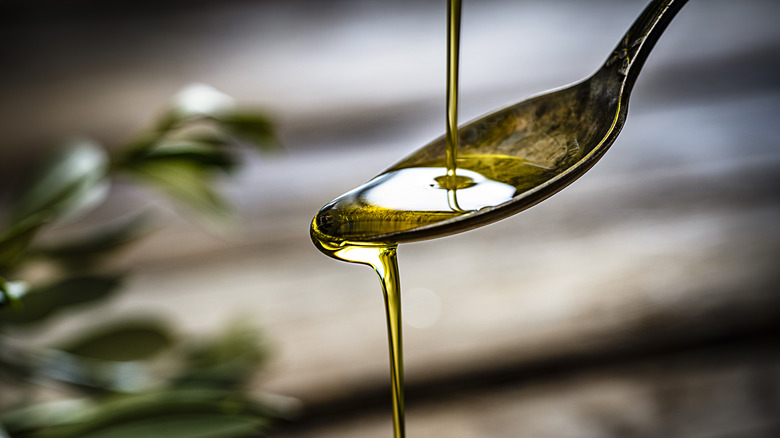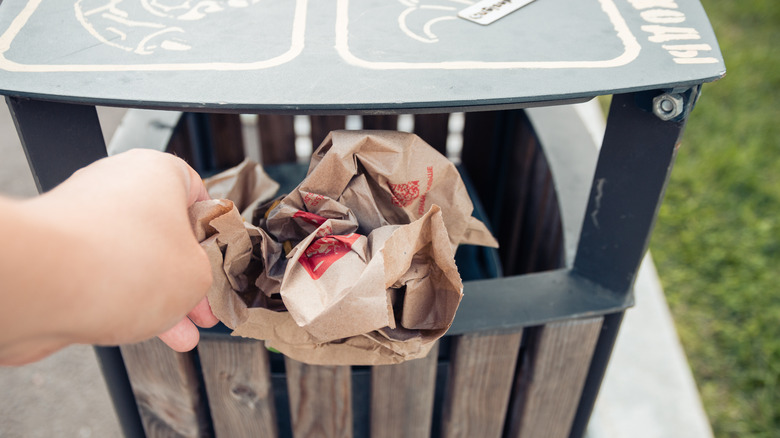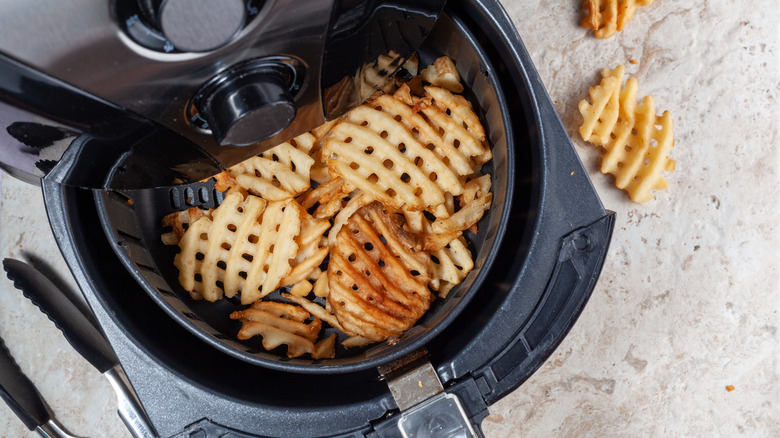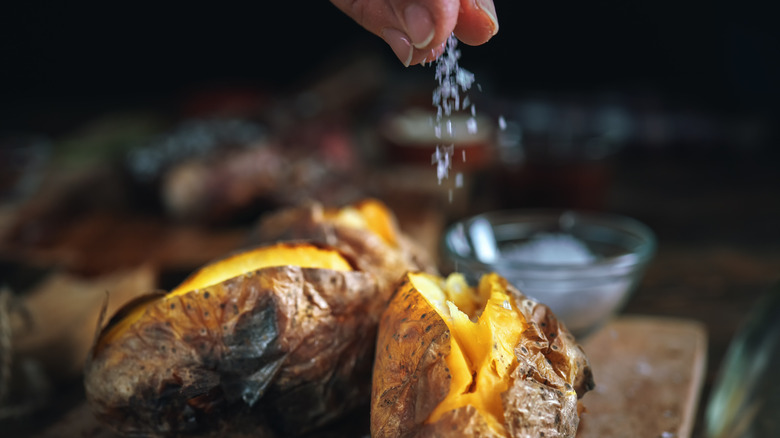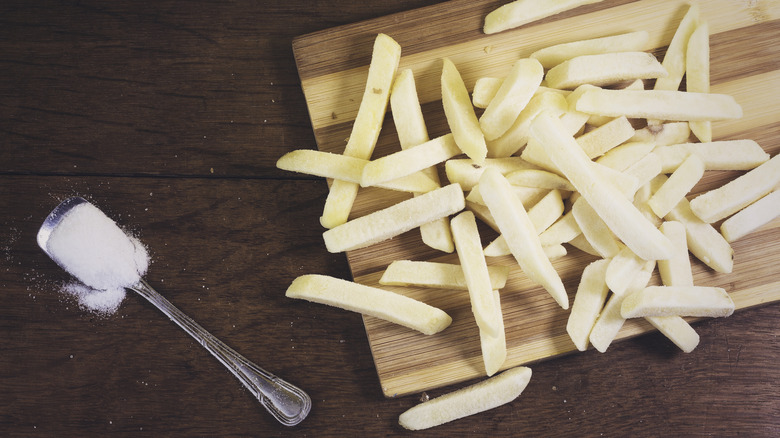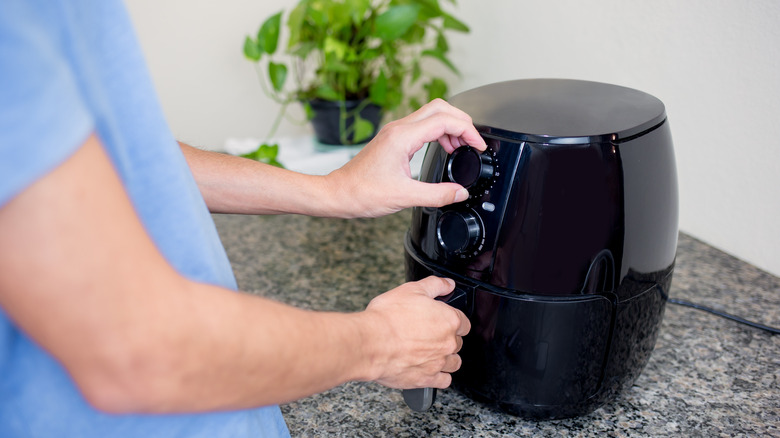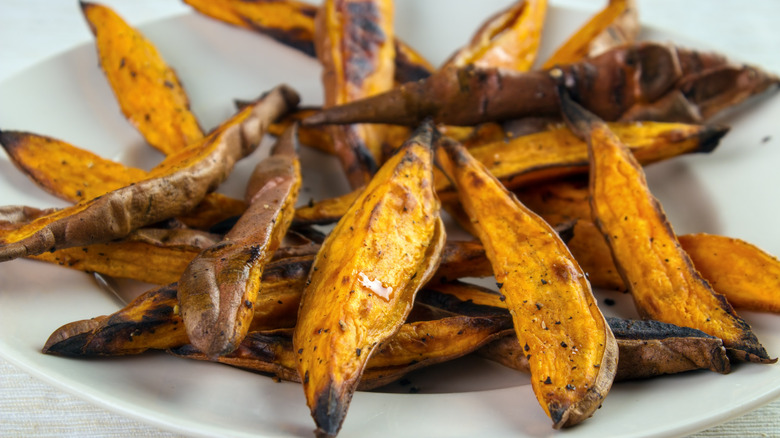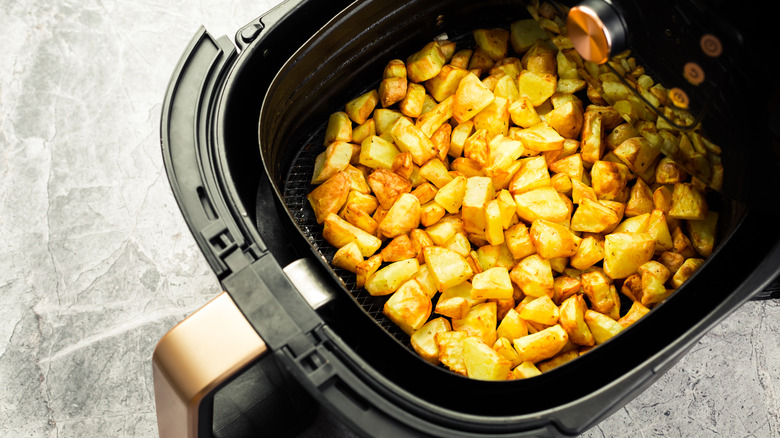12 Mistakes You're Making When Air Frying Potatoes
There are so many ways to prepare potatoes, and whether you're baking, frying, roasting, or mashing, you really can't go wrong when adding this workhorse of a root vegetable to more or less any meal. Not only are there hundreds of different kinds of potatoes, the ways of preparing them are seemingly infinite, so chances are that no matter who you are, you've had a potato that has absolutely knocked your socks off at least once in your life. And yet, no matter how many potato recipes you have in your repertoire, there are inevitably still so many methods of cooking potatoes left untried.
Perhaps one of the most popular and easy-to-use tools for cooking potatoes today is the air fryer, which allows you to cut down on the excess oil of fried potatoes. Air frying also streamlines the cooking process a bit, cutting down on the time you spend hovering over the stove without sacrificing taste. Yet, air fryers have their own quirks, and it's always handy to have a guide or two to walk you through some of them. Even if you've been using your air fryer regularly, there's always a chance that you've missed something along the way, so let's cover some basics.
Not preheating the air fryer
Air fryers might not serve quite the same function as a traditional oven, but they have a fair amount of crossover in how they operate. For instance, preheating your air fryer much the same way you'd preheat your oven might be the secret to ensuring a crispy, savory potato. While it is often said that air fryers don't need to be preheated, plenty of cooks have noticed a definite difference between the mushier results that can come from a non-preheated air fryer when compared to those that came from a preheated one, which is more akin to those that have spent time in the deep fryer or oven.
According to Reviewed writer Brigitt Earley, turning your air fryer on at about 400 degrees Fahrenheit for seven minutes before adding any food to the device could make a world of difference in your potatoes. Much the same as with a traditional oven, this can make for shorter cook times while allowing for a more evenly cooked dish in the end. With that in mind, check the food a bit earlier than you otherwise might to avoid burning. Air Fryers often skip the preheat setting, so you'll want to stay on top of setting a timer to keep track of the process, but otherwise, this is a quick and easy extra step that could very well improve your potatoes.
Overfilling the air fryer
If you're already using your air fryer for potatoes, chances are you've got your device needs all locked in. If not, be aware that air fryers come in many different shapes and sizes, and keeping in mind what your specific needs are as a cook could easily help you avoid overfilling issues before they even manifest. If you regularly cook for a group, getting a larger air fryer is a good move, while if you have limited kitchen storage, you might want a small one. Regardless of what size of air fryer you have, overfilling it with potatoes and hoping for the best is definitely ill-advised, as well as being easily avoidable.
Especially considering that fried potatoes benefit from achieving the textural balance of a crispy surface and soft insides, you want as much airflow hitting the potato surfaces as possible while avoiding undercooked centers. Unfortunately, that's exactly what can come of overfilling, so it's best to keep the recommended amount of food for your air fryer in mind while cooking. Budget a little extra time to break up your larger batches rather than cutting corners. It may seem like a time-saver, but you'll definitely lose out when it comes to taste.
Using just one recipe
Just because you're using an air fryer doesn't mean that there isn't a ton of different things you can do to spruce up your spuds. The sky is the limit when it comes to different kinds of potatoes, cuts, sauces, and seasonings, so don't let apathy dictate your meals. Taking the time to experiment in the kitchen is always a good thing, even if you end up with substandard results at times because it teaches you more about what does and doesn't work.
If you've already mastered Russet potato wedges, consider livening up your meal with sweet potato fries. If you've eaten all the fries you can stand, think about sneaking a little bit of cayenne pepper into the mix next time around for a little extra zest. Uncooked potatoes are often the culinary version of an empty canvas waiting to be styled to your unique preferences or needs, so while the appeal of sticking with a single tried and true recipe is strong, it's always good to branch out a bit to improve your familiarity with the air fryer and all it can do.
Skipping the ice soak
Some advice we give here can be applied pretty generally to potato preparation across the board, and that's true of this often-forgotten step. Many have struggled to find the sweet spot when it comes to cooking potatoes evenly inside and out. Unfortunately, this can lead to some seriously weird-tasting potatoes, too hard in the middle or burnt on the outside. To that end, you will be delighted to know that simply soaking your cut potatoes in water for a few hours before you begin cooking them can make a lot of difference when it comes to the final product.
First, you'll want to place your potatoes in water while cutting them, then drain and rinse them to remove the extra starch. Fill your container with water again, and allow the potatoes to sit until you're ready to start cooking. Using cold water is essential, as hot water will lead to all sorts of problems and definitely won't help your potatoes taste any better. Because potatoes tend to brown when exposed to air for a long time, this step slows oxidization and ensures that you can do your prep fairly far in advance without sacrificing freshness.
Foregoing the oil
While air fryers can create great results without overusing oil, that doesn't mean foregoing the oil entirely. You will want to be careful about what container the oil comes in, as many brands advise against using aerosol spray cans to prevent the interior coating of the fryer from flaking off over time. Still, you have the option of keeping an oil sprayer nearby, as that will give the benefit of the oil without the potential hazards of aerosol. Give those potatoes a nice, thin coating, and enjoy the extra crispness that comes from it.
There are plenty of different oils you can use for air frying potatoes, and vegetable, olive, and even grapeseed oil tend to be pretty popular for chefs. This is another realm where you can experiment because the oil accentuates the dish rather than fully defining its taste profile. As such, some cooks swear by using sunflower oil for frying potatoes to give them a unique gusto. Whatever specific style you use, adding oil to this vegetable before placing it in the air fryer is the kind of seemingly minor detail that can help not just with the cooking process but the overall flavor.
Throwing out the leftovers
Fried potatoes are notorious for not keeping well, and there's a reason why soggy fries can be a serious problem for fast food restaurants. Many food fans know the experience of expecting a crunch to their potatoes and instead opening the bag to discover a wilted mess. That's one reason why plenty of folks toss out old fries rather than pop them in the oven, which is time-consuming, or in the microwave, which does little to revive them. Yet, one wonderful thing about air fryers is that, by their very nature, they rely on hot air flow to heat, which makes it a lot more fruitful to take the time to resuscitate fries you might otherwise throw out.
To bring your fried potatoes back to life, you simply need to cook them in the air fryer at 350 degrees Fahrenheit for about five minutes. You likely won't have to worry about tossing the basket for an even result in this case, as the fries or wedges will already be cooked and merely need a little help getting back to temp. Likewise, you can skip the oil on this step unless you feel strongly about adding a spritz over the top because you'll have already added a bit during the initial heating process.
Forgetting the importance of weight
One of the easiest things to forget when using an air fryer is that, well, food doesn't always stay neatly in the exact spot you loaded it in. Relying on very hot air, smaller items can tend to get blown around a bit, and while that usually doesn't spell outright catastrophe, it can make for some annoying experiences when it comes to trying to recover these now scattered and sticking crisps or fries. In more extreme cases, in the case of the hyper-thin potato cuts used for chips, it can lead to a bit of scorching, which definitely isn't improving your meal.
There are a handful of ways to prevent this airy mess from ever occurring, to begin with, however. For instance, if you're dealing with larger potato slices or cubes, simply employing a few well-placed toothpicks can make a huge difference in weighing your potatoes down and hopefully making them a bit easier to manage. If you're cooking something on the lighter end of things, consider placing the air fryer rack over the food to prevent it from flying too far during the cooking process. It'll save a lot of time in the long run, and you'll thank us when you're enjoying a snack without later having to pick hardened potato remains off of the basket.
Not thinking about seasoning
Much in the same vein as the oil, one thing you do not want to get apathetic about is the kind of seasoning you plan on using. For starters, different potatoes benefit from different spices, with fries perfectly suited for some simple salt and pepper shakings but sweet potatoes require a bit more thought to bring out the specific nuance that you're going for. One way to take advantage of potatoes' versatility is to add whatever herbs you have lying around from prior meals. Chopped parsley or basil can enliven otherwise ordinary spuds, but they are far from your only option.
There are ready-made mixes available at most grocery stores that will make the act of spicing a bit easier for the cook on the go, and there's no shame in allowing the experts to perfect the mix and simply add it in at your discretion. Naturally, there are countless add-ons besides the spices that can seriously boost your potatoes, such as sour cream and cheese or even just regular old catsup and mustard. Still, sauces are best when used to heighten established flavors rather than overpowering them, and you can help define the taste by being choosy as far as what seasonings you use.
Thawing frozen potatoes
Although part of the beauty of an air fryer is the versatility that allows you to get creative with whatever you happen to be preparing, there is something still to be said for how easy they tend to be to use once you get the hang of them. That said, there will no doubt be times when you wish to keep it simple, cook up a quick, low-energy meal, and carry on with your day. Fortunately, frozen potatoes have been helping cooks save time for ages, and we're here to tell you that they might be even easier than you think. You don't need to thaw potatoes before cooking them in the air fryer; in fact, many directly advise against it.
Air fryer or not, thawing is generally discouraged due to its habit of making cooked potatoes soggy or otherwise killing the crispiness factor we're looking for. This method could save time, but the potential downsides are pretty big; you lose nothing by simply pulling the bag out of the freezer and popping the potatoes right into the air fryer. While some encourage the thawing of hashbrowns, at least due to their specific texture, most frozen potatoes are cut small and tend to thaw incredibly fast in the fryer, meaning you can skip this extra step without losing anything.
Going on autopilot
The ease of use for air fryers is one of their highest selling points, and there's little denying that they can be huge time savers in the kitchen. Yet, that can be a bit deceptive, considering that it could encourage cooks to simply wander off and wait for the timer to tell them that their food is done. Particularly when air frying potatoes, where getting an even temperature across many small surfaces at once is the goal, you will want to stay at least somewhat engaged in the experience to help your little air fryer that could be the best it can be.
One thing we suggest with most food items is to take a moment to take the handle, pull out the basket, and shake it a bit to ensure that everything is getting equal time in direct contact with the heat source. Even if you're taking our advice against overfilling your fryer, this can be a very important step in making sure that your potatoes come out tasting consistent, and you'll avoid undercooking by ensuring everything is heated equally. Besides, it only takes a few seconds, and it helps guarantee that your fries will be golden.
Peeling the skins
Frozen potatoes cut out some of the grunt work of creating the perfect fry or wedge, but something must be said about the magic of cutting potatoes yourself. This gives you more control over the shape, which in turn grants greater agency over how they end up tasting. Control is always a good thing in the kitchen, and so we're big fans of taking the extra time to use fresh ingredients whenever possible. However, even if you're a veteran when it comes to potato cutting, there's another tip that we have that could potentially improve your potatoes.
Rather than peeling the skins, you might consider skipping that step and leaving them on. There are a lot of reasons to do this, with taste being a major factor for many chefs that insist on going this route. Further, it can add some extra crispiness to your potatoes, as the outer layer tends to interact with heat nicely. Finally, this approach also has health benefits, considering that most of the essential vitamins you get from potatoes, such as fiber, potassium, and vitamins C and B, come from their skins.
Forgetting to convert
With the famed simplicity of the air fryer, there is one major mistake that plenty of people make when using one; you forget to adjust heat and time to accommodate this unique kitchen tool. This doesn't entail starting over from scratch with your recipes. Simply keep in mind that your oven and your air fryer have different quirks, and it's to your own benefit to figure them out accordingly. This relies strongly on what kind and size of air fryer you're using, so be sure to check the specifics for this step. With recommended times for French fries varying from ten to twenty minutes, the devil is in the details.
This is a general point of advice for air fryers, but it applies to potatoes as well, as they specifically tend to be difficult when it comes to ensuring an even cook. While you'll want to check on your individual recipes to make sure that you're doing things according to the experts, a general rule of thumb with air fryers is to lower the temperature by 25 degrees Fahrenheit and to shave about twenty percent of your overall cooking time off the top.
